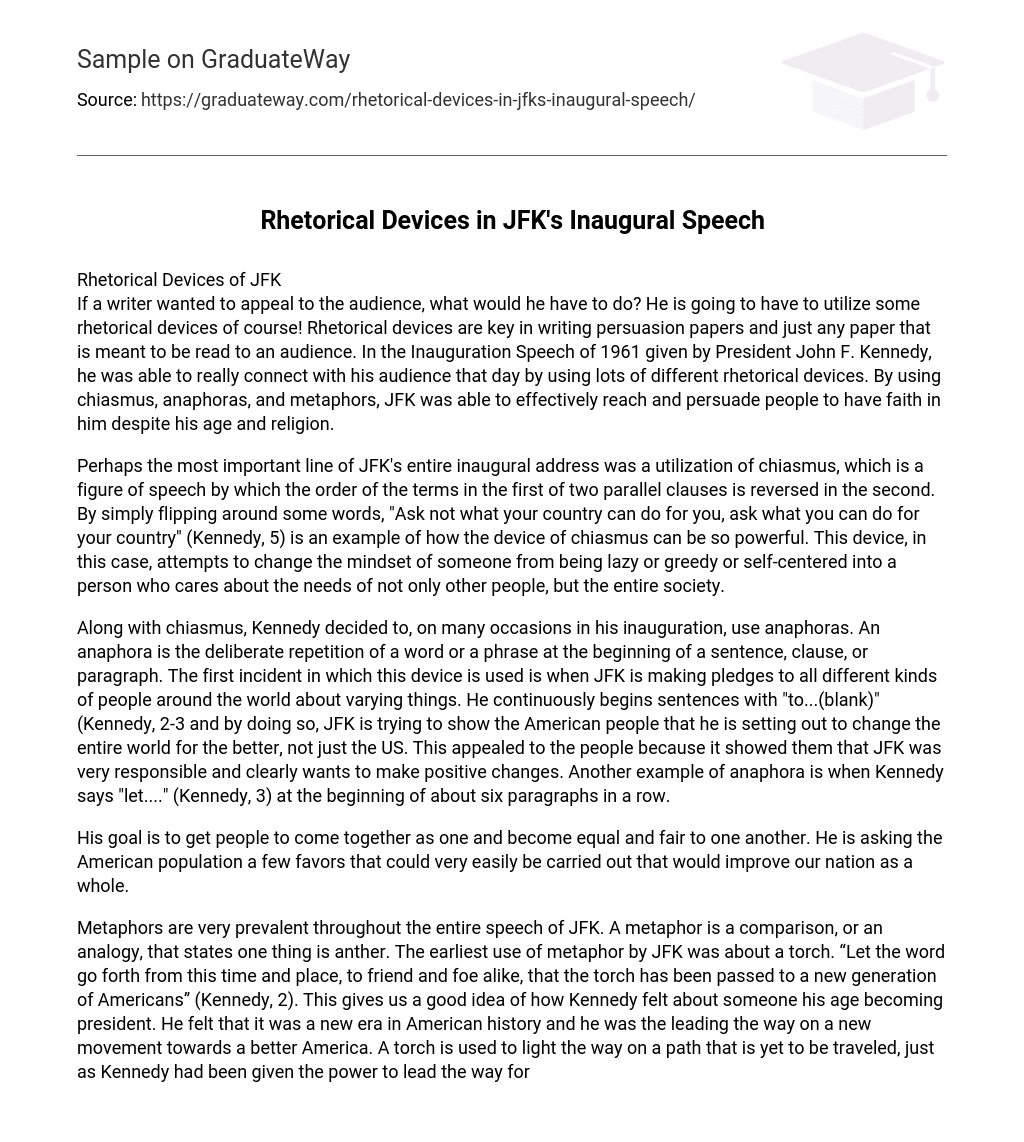Rhetorical Devices of JFK
If a writer wanted to appeal to the audience, what would he have to do? He is going to have to utilize some rhetorical devices of course! Rhetorical devices are key in writing persuasion papers and just any paper that is meant to be read to an audience. In the Inauguration Speech of 1961 given by President John F. Kennedy, he was able to really connect with his audience that day by using lots of different rhetorical devices. By using chiasmus, anaphoras, and metaphors, JFK was able to effectively reach and persuade people to have faith in him despite his age and religion.
Perhaps the most important line of JFK’s entire inaugural address was a utilization of chiasmus, which is a figure of speech by which the order of the terms in the first of two parallel clauses is reversed in the second. By simply flipping around some words, “Ask not what your country can do for you, ask what you can do for your country” (Kennedy, 5) is an example of how the device of chiasmus can be so powerful. This device, in this case, attempts to change the mindset of someone from being lazy or greedy or self-centered into a person who cares about the needs of not only other people, but the entire society.
Along with chiasmus, Kennedy decided to, on many occasions in his inauguration, use anaphoras. An anaphora is the deliberate repetition of a word or a phrase at the beginning of a sentence, clause, or paragraph. The first incident in which this device is used is when JFK is making pledges to all different kinds of people around the world about varying things. He continuously begins sentences with “to…(blank)” (Kennedy, 2-3 and by doing so, JFK is trying to show the American people that he is setting out to change the entire world for the better, not just the US. This appealed to the people because it showed them that JFK was very responsible and clearly wants to make positive changes. Another example of anaphora is when Kennedy says “let….” (Kennedy, 3) at the beginning of about six paragraphs in a row.
His goal is to get people to come together as one and become equal and fair to one another. He is asking the American population a few favors that could very easily be carried out that would improve our nation as a whole.
Metaphors are very prevalent throughout the entire speech of JFK. A metaphor is a comparison, or an analogy, that states one thing is anther. The earliest use of metaphor by JFK was about a torch. “Let the word go forth from this time and place, to friend and foe alike, that the torch has been passed to a new generation of Americans” (Kennedy, 2). This gives us a good idea of how Kennedy felt about someone his age becoming president. He felt that it was a new era in American history and he was the leading the way on a new movement towards a better America. A torch is used to light the way on a path that is yet to be traveled, just as Kennedy had been given the power to lead the way for our country down the unlit path and decide for us whether or not we will prosper.
Without the use of rhetorical devices, writers would be lost. There would be no way for them to pull the reader into what they have to say. John F. Kennedy sure knew how to woo people with his words and thank goodness he did. If he didn’t have rhetorical devices, Kennedy never would have been able to get the message of what he was trying to achieve across to his readers and listeners and probably never would have gained as much support as he did. Rhetorical devices not only make a piece of writing sound better, but they make it more powerful as well, as long as you know how to read between the lines.





